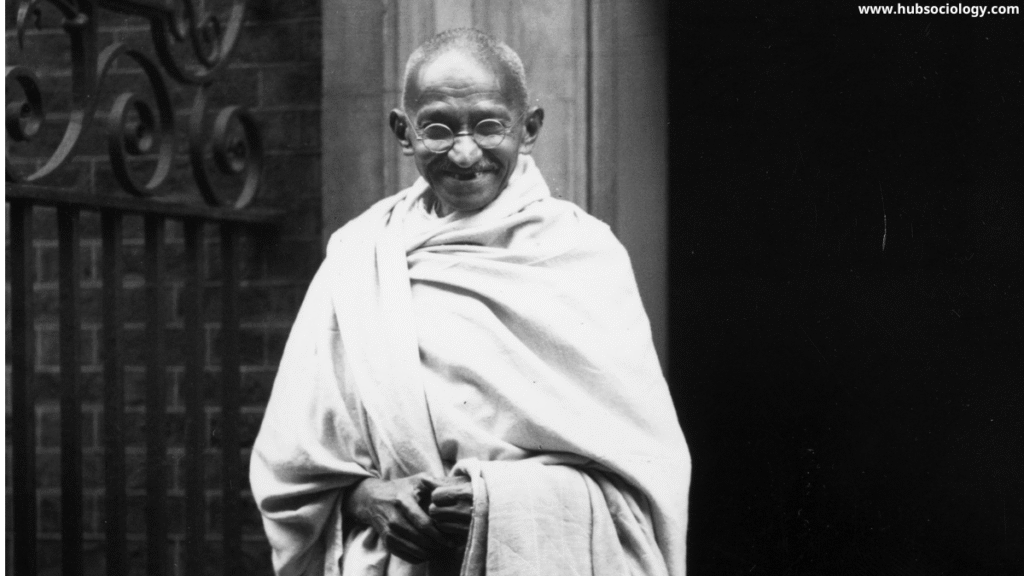Introduction on Gandhian Model of Development
The Gandhian model of development represents a holistic vision that integrates economic progress with moral, social, and spiritual well-being. Unlike the Western industrial model, which emphasizes material growth and technological expansion, Mahatma Gandhi’s development philosophy cantered around human dignity, community welfare, and ecological harmony. From a sociological standpoint, the Gandhian model is not merely an economic blueprint—it is a social doctrine rooted in values of equality, simplicity, and self-reliance. Gandhi viewed development as a means to strengthen the moral fabric of society, not merely to increase its wealth.
The Sociological Foundation of Gandhian Development

Sociologically, Gandhi’s model of development is grounded in his understanding of society as an organic whole—where individuals, families, and communities are interdependent. He believed that true progress could not be measured by industrial output or GDP, but by the moral and spiritual strength of the people. In this sense, the Gandhian model emphasizes social relationships, ethical production, and participatory development.
The Gandhian model sought to overcome the alienation created by industrial capitalism. Modern industrial society, Gandhi argued, tends to break down social bonds, foster competition, and lead to exploitation. Therefore, he proposed a model where social cooperation, mutual aid, and community life take precedence over profit-oriented individualism.
At its core, Gandhian sociology is built upon several key concepts—Sarvodaya (welfare of all), Swaraj (self-rule), Swadeshi (self-reliance), and Trusteeship. Each of these principles contributes to a sociological framework for a humane and sustainable society.
Sarvodaya: Welfare of All
The concept of Sarvodaya, meaning “the rise or welfare of all,” is the cornerstone of Gandhian social philosophy. It rejects the capitalist notion of development where prosperity is concentrated in the hands of a few, as well as the Marxist emphasis on class conflict. Instead, Gandhi envisioned a classless, cooperative society where social harmony prevails.
From a sociological perspective, Sarvodaya emphasizes collective responsibility and interdependence. It promotes the idea that true development cannot occur at the expense of any group. Every individual, regardless of caste, class, or gender, must have access to basic needs—food, shelter, education, and dignity. In this way, Sarvodaya aligns closely with the concept of social justice and inclusivity, which are central themes in modern sociology.
Gandhi’s idea of Sarvodaya also finds resonance in today’s movements for inclusive growth and sustainable development, which stress the need to balance economic advancement with social welfare and environmental preservation.
Swaraj: Self-Rule as Social Empowerment
Swaraj or self-rule, for Gandhi, extended beyond political independence. It meant the moral and social empowerment of individuals and communities. In a sociological sense, Swaraj represents autonomy, participation, and decentralization—each essential for the democratization of society.
Gandhi believed that true freedom lies in self-discipline and local self-governance. His idea of village republics (Gram Swaraj) reflects his vision of a decentralized society where people collectively manage their affairs. Each village, according to Gandhi, should be an autonomous unit capable of meeting its basic needs through cooperation and local resources.
From a sociological standpoint, Swaraj promotes community solidarity and participatory democracy. It empowers individuals to take control of their own development rather than depend on distant bureaucracies or industrial monopolies. This idea aligns with contemporary sociological theories of grassroots development and bottom-up governance.
Swadeshi: Self-Reliance and Economic Ethics
The principle of Swadeshi—meaning reliance on one’s own resources—was central to Gandhi’s critique of industrial capitalism and colonial exploitation. He advocated for local production, cottage industries, and handicrafts as means to achieve economic self-sufficiency and preserve social harmony.
From a sociological angle, Swadeshi reinforces cultural identity and community cohesion. By encouraging local production and consumption, Gandhi sought to strengthen rural economies, reduce inequality, and sustain traditional crafts and skills. He saw the import of foreign goods and mass production as threats to indigenous culture and social structures.
Modern sociological analysis recognizes that Swadeshi anticipated many aspects of what we now call sustainable development and localization. It challenges the homogenizing forces of globalization and consumerism by emphasizing ethical consumption, ecological responsibility, and cultural diversity.
Trusteeship: Ethical Ownership and Social Responsibility
The idea of Trusteeship represents Gandhi’s attempt to reconcile wealth with moral responsibility. He believed that those who possess wealth should act as trustees for the welfare of society. Wealth, according to Gandhi, is not a private possession but a social trust to be used for the benefit of others.
From a sociological perspective, Trusteeship offers a framework for ethical leadership and corporate social responsibility. It rejects both extreme capitalism and violent socialism, proposing instead a moral economy where wealth is distributed fairly through voluntary sharing and social conscience. This principle seeks to minimize class conflict by fostering mutual respect and cooperation between workers and employers.
In modern terms, Gandhi’s Trusteeship can be seen as an early form of social capitalism or stakeholder theory, where economic actors are accountable to the broader community, not just shareholders.

Village Republics: The Sociological Ideal
For Gandhi, the village was the nucleus of Indian civilization. He saw the village not as a backward remnant but as a potential model for sustainable living. His idea of Gram Swaraj envisioned a network of self-reliant villages, each functioning as a small republic governed by direct democracy and moral values.
Sociologically, this vision aligns with the idea of communitarianism, where social relations and moral norms are guided by collective values rather than impersonal market forces. Gandhi believed that decentralized village life would prevent urban overcrowding, class inequality, and environmental degradation.
Modern sociologists find relevance in Gandhi’s village ideal in the context of rural development, local governance, and environmental sociology. His emphasis on small-scale production, local autonomy, and ecological balance anticipates many contemporary debates on sustainable living and rural revitalization.
Critique of Modern Industrial Civilization
Gandhi’s critique of modern industrialism was not anti-progress but rather a sociological warning against dehumanization, inequality, and ecological destruction. He observed that industrial development, while materially enriching, often impoverishes moral and social life. The factory system, according to him, created alienation, exploited labor, and widened the gap between rich and poor.
His rejection of mechanistic progress aligns with sociological critiques by thinkers like Émile Durkheim and Karl Marx, who also warned of the breakdown of social solidarity and human values in capitalist societies. Gandhi, however, proposed a nonviolent, ethical alternative based on moral progress and self-restraint.
In today’s era of climate change, consumerism, and social fragmentation, Gandhi’s critique appears remarkably prophetic. Sociologists now recognize that unchecked industrial growth can lead to anomie, inequality, and environmental crisis—all of which Gandhi had foreseen.
Relevance of Gandhian Model in Contemporary Society
In the 21st century, Gandhi’s development model remains a vital sociological framework for addressing global challenges such as inequality, unemployment, environmental degradation, and moral decay. Concepts like local self-reliance, ethical economy, participatory democracy, and sustainable living are being rediscovered through Gandhian thought.
Movements such as eco-villages, slow living, fair trade, and community-based development reflect Gandhian principles in practice. In India, initiatives like rural self-help groups, Panchayati Raj institutions, and the emphasis on Gram Sabha democracy are sociological extensions of Gandhi’s vision.
Moreover, Gandhi’s insistence on nonviolence (Ahimsa) as a social ethic reminds us that development without compassion leads to social disintegration. His belief that moral progress and social equality must guide economic growth remains as relevant as ever.
Conclusion
The Gandhian model of development, when viewed sociologically, transcends the boundaries of economics and politics. It envisions a civilization grounded in moral values, community cooperation, and human dignity. Gandhi offered a vision where development is not measured by material wealth but by the quality of human relationships and the moral integrity of society.

In an age of growing inequality and ecological crisis, Gandhi’s model offers a timeless sociological alternative—one that seeks harmony between man, society, and nature. It calls upon humanity to replace competition with cooperation, greed with trusteeship, and industrialism with moral progress. Thus, the Gandhian model remains not a relic of the past but a guiding light for the future of humane development.
Do you like this this Article ? You Can follow as on :-
Facebook – https://www.facebook.com/hubsociology
Whatsapp Channel – https://whatsapp.com/channel/0029Vb6D8vGKWEKpJpu5QP0O
Gmail – hubsociology@gmail.com
Topic Related Questions
5 Marks Questions
- What do you understand by the term Gandhian Model of Development?
- Mention any two key principles of the Gandhian Model of Development.
- Explain the sociological importance of Sarvodaya in the Gandhian Model of Development.
- What role does Swaraj play in the Gandhian Model of Development?
- How does the Gandhian Model of Development differ from Western industrial models?
- What is the relevance of Trusteeship in the Gandhian Model of Development?
- Define Swadeshi in the context of the Gandhian Model of Development.
- Briefly explain Gandhi’s idea of village republics in his model of development.
- How is self-reliance emphasized in the Gandhian Model of Development?
- What is the sociological aim of the Gandhian Model of Development?
10 Marks Questions
- Discuss the major sociological features of the Gandhian Model of Development.
- Explain how Swaraj, Swadeshi, and Sarvodaya contribute to the Gandhian Model of Development.
- Analyze the concept of Trusteeship and its sociological relevance in the Gandhian Model of Development.
- Examine how the Gandhian Model of Development addresses issues of inequality and social justice.
- Compare the Gandhian Model of Development with modern industrial or capitalist models of development.
- Evaluate the role of village communities in the Gandhian Model of Development.
- How does the Gandhian Model of Development promote sustainable and inclusive growth?
- Discuss the importance of ethical and moral values in the Gandhian Model of Development.
- Explain how the Gandhian Model of Development can be applied in contemporary India.
- What are the main criticisms of the Gandhian Model of Development from a sociological point of view?
15 Marks Questions
- Critically analyze the Gandhian Model of Development as a sociological alternative to industrial capitalism.
- Examine the sociological foundations of the Gandhian Model of Development and its relevance in the 21st century.
- Discuss how the Gandhian Model of Development integrates moral, economic, and social dimensions of progress.
- Evaluate the Gandhian Model of Development in the light of theories of sustainable and participatory development.
- Analyze the relationship between Sarvodaya, Trusteeship, and Swaraj in the Gandhian Model of Development.
- Assess the strengths and limitations of the Gandhian Model of Development in addressing poverty and inequality in rural India.
- How does the Gandhian Model of Development reflect a holistic approach to human and social development?
- Compare the Gandhian Model of Development with Marxist and modernist approaches to development.
- Discuss the Gandhian Model of Development as a form of decentralized and people-centered development.
- Critically discuss the relevance of the Gandhian Model of Development in an era of globalization and consumerism.
